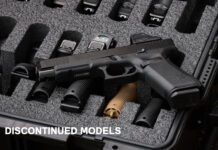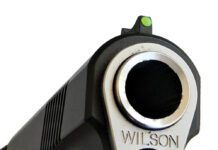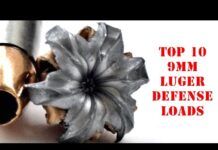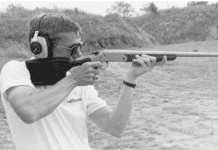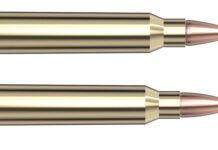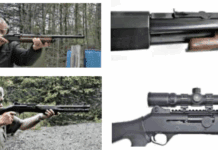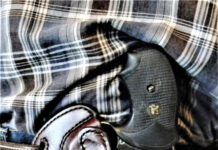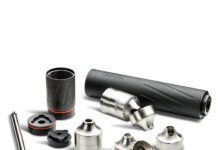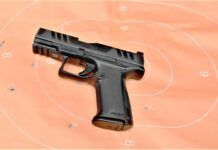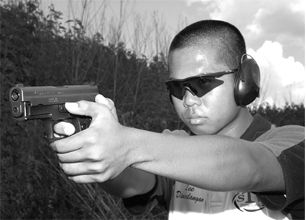
We’re not sure what role reader mail plays in the selection of articles for other publications, but not long ago we were informed by U.S mail that we had skipped over a pistol that should have been tested long ago: The Sigarms P229R-9 in 9mm. We secured a P229R-9 with accessory rail and discovered two additional 9mm DA-to-SA guns that had successfully flown beneath our radar. They were the Magnum Research Baby Eagle and the Pro-9 pistol manufactured by Browning.
We had tested the venerable P229 in .357 Sig and .40 S&W many times, but the 9mm had somehow slipped by us. The other two guns are of more recent vintage, but as 9mms, they belong to a wide and deep river of high-cap pistols that shoot softly and carry easily. We are always interested in such guns.
In particular, besides our regular accuracy testing, we also wanted to find out how well each gun performed in rapid-fire drills that required a smooth transition from double action to single action. To test this transition, we set up a Hoffners ABC16 target (hoffners.com) at 7 yards. The ABC16 target featured a humanoid silhouette with a 5.5- by 8-inch A zone at center mass and an upper B zone, which consisted of a half circle 5 inches in diameter to represent the head.
The course of fire required the shooter to move the gun from a low-ready position, hammer down, double-action first shot. On a start signal, the shooter brought the gun on target and fired twice at the A zone, allowing the gun to transition to single action for the second shot. Then he brought the sights up to the B zone for one single-action shot. We did this 10 times per gun, for a total of 30 shots. Here is what we found during that test, and elsewhere.
[PDFCAP(1)]
Sigarms of Exeter, New Hampshire, is both an importer and a manufacturer. The alloy frame of the Sigarms P229 pistols are made in Germany, and the stainless-steel slides are manufactured in the U.S. The P229-series guns are midsize entries in the Sigarms lineup.
The P229R-9 featured a 3.9-inch barrel and a grip that was abbreviated just enough to make it more concealable. For example, capacity was 13 rounds compared to 15 rounds found in the grip of the full-size P226. The textured plastic grip covered the back strap as well as the sides, offering a flowing snag-free design and a round feeling in the hand. We think this will be most noticeable to shooters who are used to pistols with single-column magazines or other designs that leave a boxier impression.
The smooth profile of the grip was an advantage when it came to operating the magazine release, decocker and the slide release, all of which were mounted on the left side of the frame. Even the shooter in our group with the smallest hands and fleshiest palms could spin the gun quickly toward the desired lever. Magazine changes were lightning fast. The only drawback we have heard regarding the placement of so many controls in close proximity to each other was from a number of professional trainers who feel that under stress the wrong lever or button may be activated by mistake.
The distinguishing feature on the P229R-9 pistol was the accessory rail with no less than three notches in the dustcover for versatility in mounting different types of lights or lasers. Otherwise, the frame appeared to be unchanged from previous models, showing a black, low-gloss finish that Sigarms calls Nitron.
Fine horizontal lines were cut into the front strap. The slide offered only rear cocking serrations and an external extractor. The extractor did bulge slightly when the chamber was loaded, but we could find no reference in the owner’s manual recommending the extractor double as a chamber indicator.
Sights were dovetailed into place, and SigLite night sights are available. Our P229R-9 was equipped with the standard sights that we liked very much. The front sight showed a white dot, and a white vertical line accented the rear notch. During our drills, we found lining up a round dot atop a rectangle to be very easy. We would like to see this set up made available with tritium.
[PDFCAP(2)] we tested with 115-grain FMJ rounds from Winchester that are available for under $10 per 100 rounds at Wal-Mart. We also fired more expensive self-defense loads from Hornady (115-grain JHP/XTP) and some 124-grain GDHP rounds from Speer. The P229R-9 set the bar in terms of accuracy by printing five-shot groups from a 25-yard rest that measured less than 2 inches across on average for both of our defense loads. The FMJ Winchester “Q” loads (recognizable by the white cardboard boxes) averaged 2.2 inches. The 124-grain GDHP (Gold Dot Hollow Points) produced the most power. Flying at an average velocity of 1127 fps, they produced 350 foot-pounds of muzzle energy. We shot the accuracy portion of the test single action.In the DA-to-SA transition test — how they would most likely be used in a defensive situation —we shot Winchester 115-grain FMJ rounds. Perfect performance in the A zone would have been 20 shots (10 initial DA shots followed by 10 SA shots), followed by a perfect 10 shots in the B zone. Using the Sig, we put 17/20 shots inside the center mass A zone, and 7/10 shots in the B head zone.
The trigger pull weights were 7.0 and 13 pounds, single and double action respectively. This was the heaviest among our test pistols, but we thought the transition between the two modes was very smooth.
[PDFCAP(3)]
The Browning Pro-9 shared some basic design features with the Sigarms P229R-9, but had some interesting differences as well. Barrel length was slightly longer (4 inches), and the routine to remove the top-end barrel support was the same.
After locking back the slide and rotating the latch downward, we found a linkless barrel. A block with rails on each side plus two more metal rails at the rear supported the barrel and slide.
The slide featured rear cocking serrations only, an externally mounted extractor and a three-dot sight system dovetailed into place front and rear. The contours cut into the slide were similar to that of the Sigarms P229R-9.
Unlike the Sigarms gun, the guide-rod assembly utilized a captured two-piece flat wound recoil spring. The guide rod of the Sigarms P229R-9 does not capture the spring, and the Sigarms spring is multifilament. The frame of the Pro-9 was black composite accented by the stainless steel slide and stainless control levers (slide latch, slide release, magazine release button and decocker, all of which were located on the left side of the frame). The shooter could work the decocker on both sides of the frame. It was mounted to the rear instead of at the front of the grip like the Sigarms design. We found access to the decocker on the Pro-9 to be much easier because we did not have to shift our grip to use it. Another variation from the Sigarms design was the magazine disconnector that deactivated the trigger when the magazine was not in place. The Pro-9’s polymer frame helped it come in 6 ounces lighter than the alloy-framed P229R-9.
Also, the Pro-9 included a replaceable backstrap. By removing one screw, the shooter could slide a flat or arched grip onto the gun, a process that could be done very quickly. Our choice was the arched piece. Both the front and back strap offered the shooter a checkered pattern molded into the polymer. The sides of the grip showed an arc-like sweep, which was likely a reference to the famous grip found on the Browning Hi-Power. We felt that this contour, although good looking, did impede efforts to press the magazine release. The supplied magazines for our Pro-9 consisted of a polished stainless steel body that held 10 rounds. Fifteen-round magazines cost $42.
At the range, we immediately noticed how easy the Browning Pro-9 was to shoot. Hand to gun fit was very good, though a bit slippery for the weak hand. This is an ongoing problem for many polymer pistols. From the bench we did not print a single five-shot group that measured less than 2 inches across. Also, all but one of our groups fell in the 2.3- to 2.8-inch range with all three test ammunitions. The P229R-9 did record tighter groups, but we can’t overstate our satisfaction with a pistol that shot this level of accuracy at 25 yards with any ammunition.
In the DA/SA transition test, we shot 17/20 bullets in the A zone, and 8/10 in the B zone. Both the accuracy and transition results were due in part to the gun’s quality trigger. The single-action trigger pull registered as 5 pounds, and the double-action pull was 12 pounds.
[PDFCAP(4)]
This Israeli-made pistol is referred to as the baby of the Magnum Research Desert Eagle line. The sweeping lines of this pistol were very appealing. The dustcover went all the way to the muzzle and was sculpted with a diagonal cut. The grip was gracefully undercut at the trigger guard and flared out at the magazine well. A grip safety was not included, but a beavertail to cover the web of the strong hand was.
The grip was long, with a palm swell at the bottom. The decocker/safety levers were mounted on the slide and and could be operated from either side, much like a Beretta. After the lever has been pushed down to lower the hammer, it must be manually raised again to reconnect the trigger. But if the Baby Eagle owed its form to any other design, that pistol would be the CZ75. To find out how the guns were similar, we began removing the top end. We pushed the slide backward about a quarter-inch and aligned two guide dots, one in the frame and another in the slide. Then we pushed out the slide stop from right to left and pulled the slide forward from the frame. Inside we found typical CZ traits.
The frame rails faced inside rather than along the outer edge. The frame was heavy steel not alloy or polymer. The guide rod was a thin steel rod, and two lugs machined into the inner roof of the slide forward of the ejection port achieved lockup. With this type of construction, this pistol should be nearly indestructible, but Magnum Research does not recommend or warranty the Baby Eagle for use with +P or +P+ ammunition. The gun came with 10-round magazines, but 15-round mags are available for $35 each.
We thought the pistol was very comfortable in the hand. But from the start, the left-side grip panel was loose. We never were able to get it tight enough, and it became a constant distraction. We also noticed that the rear sight didn’t match the height of the front blade. Indeed, at the range our Baby Eagle printed groups more than 8 inches high. Also, most of the groups we recorded measured in the 3-inch range, probably the result of two factors. First, there was some play in the way the gun locked up. Next, we found the single-action trigger to be unpredictable. Sometimes we experienced a lot of grit and creep, and sometimes we did not. Some shots were spoiled because the rough trigger seemed to produce a false break, spoiling our aim. Other times, the trigger felt smooth. We did record one really tight group firing the Hornady 115-grain JHP/XTP rounds, during which the trigger moved without hesitation five consecutive times.
With the problems we experienced from the bench, we did not expect the Baby Eagle to excel in our transition test. Even at 7 yards, we expected an elevation problem, and we were concerned about the trigger. But the superb grip frame, even with the insecure grip panels, served us very well. Shooting standing off hand, fired with a strong consistent stroke, we didn’t notice the shortcomings that were so evident when we were at the bench. We landed 18/20 shots into the A zone, with only two shots high. The effect of the poorly matched sights was most noticeable among the shots in the upper B zone. There, 8/10 shots were high, but six of those shots were in a 1-inch group.
Gun Tests Recommends
• Sigarms P229R-9 9mm, $860. Our Pick. The Sigarms transition from double to single action fire is still among the best. Accuracy was outstanding.
• Browning Pro-9 9mm, $628. Buy It. The Pro-9 offers the advantages of a polymer frame, but has the feel of a more traditional pistol by relying upon hammer-driven fire rather than a striker. Safety features such as a decocker and a magazine disconnector are a plus.
• Magnum Research Baby Eagle MR9900, $499. Conditional Buy. If you used the price difference to have a gunsmith fix the sights, resolve the grip looseness, and get a trigger job, this gun would be worth buying.


